
|
INTERNATIONAL TREASURES
Italy, The Palio and the Vatican
|
|
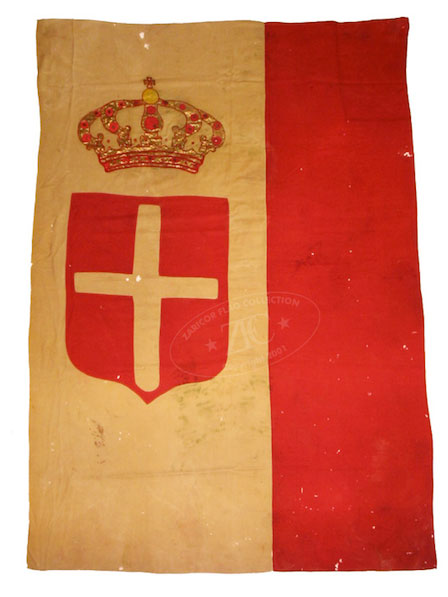
|
ZFC1431Â Fragment of an Ensign from Kingdom of Italy 19th century. This flag dates from the last third of the 19th century. This fragment is a variant because it omits the blue border around the Savoy arms of the official version of the flag the Kingdom of Italy adopted in 1866. The ornate embellishments on the crown and vernacular construction suggest private use. In the 19th century, green was made of a harsh and unstable dye, which degraded the fabric over time so that Italian flags from
this era are often seen without the green hoist panel. Read more
|
|
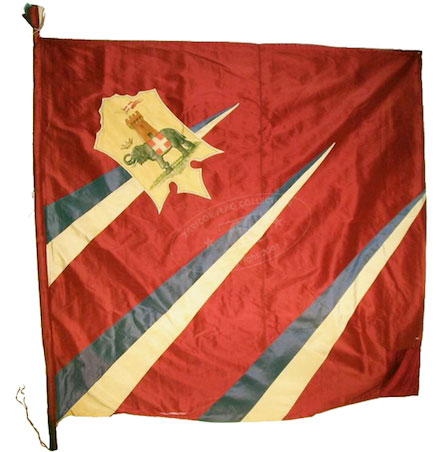
|
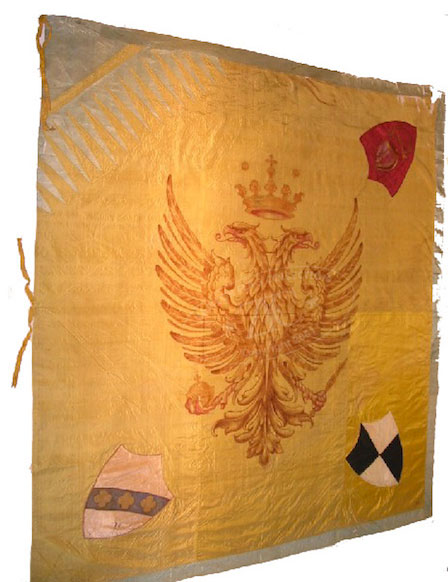
|
|
ZFC0225 Italy, Tower Contrada Flag, 1888. This flag was used by the Tower Contrada (district) in the city of Siena. The tower appears as a howdah on the back of the elephant in the shield. It rests on a red caparison bearing a white cross. This white-cross-on-red is the symbol of the Kingdom of Savoy, whose ruling dynasty provided the kings of the modern, united Italy. The Savoy arms appear in the Tower shield by special grant from King Umberto I, following his visit to Siena in 1887. The background colors of the Tower flag have been in use since the 17th century – dark red, white,
and medium blue. Read more
|
ZFC0414 Italy, The Eagle Contrada, pre-1887. This Eagle Contrada (district) flag predates the 1877 visit of King Humbert I to Siena. The eagle symbol was originally derived from the Marescotte family coat of arms. In its present form, however, it is symbolic of the Holy Roman Emperor Charles V, who in 1536 granted use of the name “Noble Contrada†and of the imperial eagle – i.e. a two-headed eagle with scepter and orb on a
gold background. Read more
|
|
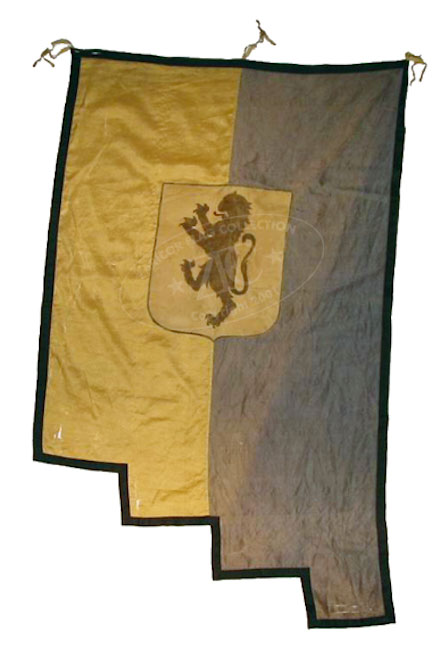
|
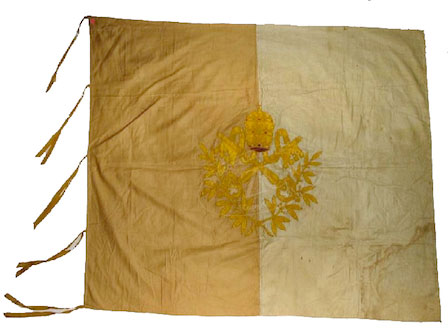
|
|
ZFC0226Â Italy, the Panther Contrada, 1870s. This hand stitched silk banner with a stylized panther painted on the central shield is from the Pantera district of western Siena. Traditionally inhabited by chemists and grocers, the Pantera Contrada is an archrival of the Aquila (Eagle) Contrada (See ZFC0414). Read more
|
ZFC0222Â Vatican - A Papal Military Color of the Pontifical States circa 1870s. The Pontifical States (also known as the Papal States) were sovereign until 1870 when it was absorbed into a united Italy. Its ruler, the Pope, withdrew to the Vatican Palace and refused to deal with the Italian government until the Lateran Treaty was signed in 1929 establishing the State of Vatican City as a sovereign country. However, during this period the Pope still maintained ceremonial military units and this color dates from this period. Read more
|
|
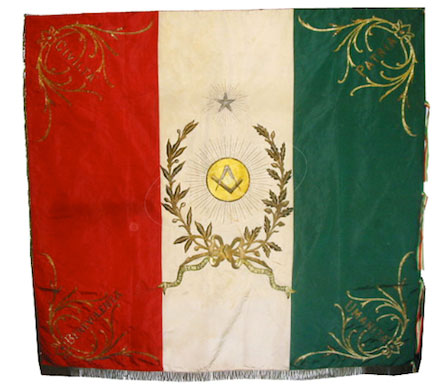
|
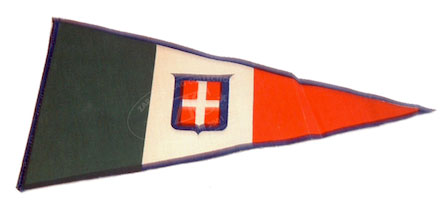
|
|
ZFC0991Â Italia Associazione Gian Battista Amendola da Sarno The Association of John the Baptist of Sarno [Italy]), New York, 1904. This ornately embroidered Italian tricolor is double-faced. The flag bears the royal Italian arms on the obverse and the Masonic level and dividers on a sun. Fraternal associations were common in the immigrant communities of the large coastal cities of the United States. Organizations like this were founded for mutual benefit, fraternization, socialization, and preservation of identity and culture. The flag of this group from Sarno, Italy combines Royal Italian, Masonic and Religious symbols. Read more
|
ZFC3151Â Italian Civil Pennant. Small pennants like this, bearing the uncrowned 1866 to 1946 Italian arms would have been used primarily for decorations or patriotic purposes. They could have also been used on small Italian pleasure craft or other small boats. Read more
|
|
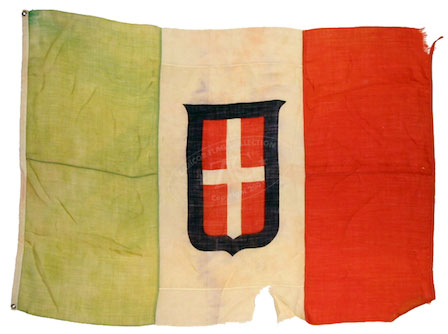
|
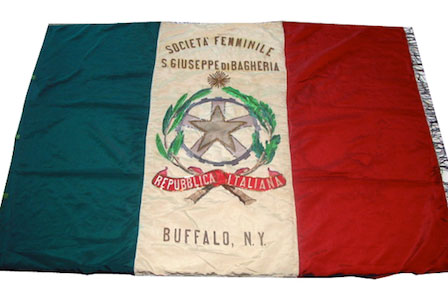
|
|
ZFC0329 Civil and Merchant Flag from the Kingdom of Italy. This was the “Merchant Flag†of Italy from 1866 to 1946. Examples like this American-made flag were used by U.S. merchant marine vessels trading with Italy. They were also very popular with Italian American emigrant groups in the United States. This wool flag is marked in feet with metal grommets; the hallmarks of American, rather than European, manufacture. Read more
|
ZFC0986 Italian - Societa Femminile S. Giuseppe Di Bagheria. Buffalo, New York – This is the flag of the Women of the St. Joseph Di Bagheria Society, an Italian-American non-profit organization founded in 1938. The flag bears the arms of the Italian Republic, adopted in 1948; the reverse displays the arms of the city of Bagheria, Sicily. The St. Joseph di Bagheria Society was founded in 1900 to aid recently arrived Italian emigrants. Read more
|
|

|
|
ZFC1061 Italian National Flag, 2001. Flags always have been and remain a popular souvenir for travelers as in this example from Italy. It is inscribed “Italian national flag obtained in Florence, Italy by the Zaricor Family, June 29 2001.†This flag was acquired new and is an exception in the Zaricor Flag Collection, which almost always acquires used and historical flags. Read more
|

|
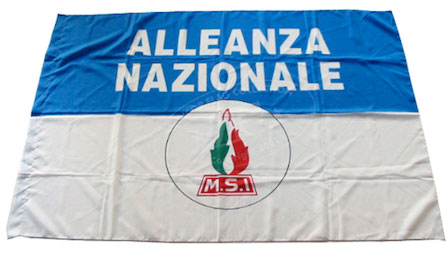
|
|
ZFC2211 Italian Merchant Flag. The Italian flag overlaid with the arms of the four so-called “Sea Republics,†which are, by tradition: Venice, bearing the winged lion of St. Mark’s; Genoa, with a red cross on white; Amalfi, showing a white Maltese cross on blue; and Pisa, flying a Pisan cross with keys (or paws) and three spheres on every arm. Adopted in 1947, the Italian merchant flag is used on Italian pleasure craft and merchant vessels. Read more
|
ZFC1900Â Italian Alleanza Nationale (National Alliance), 1995 to 2009. The Alleanza Nationale was an Italian conservative political party that formed when the neo-fascist Italian Social Movement joined forces with elements of the defunct Christian Democracy party to form a mainstream Italian right-wing political party.
They participated in three Italian coalition governments until they merged with the center-right People of Freedom Party in 2009. Read more
|
|
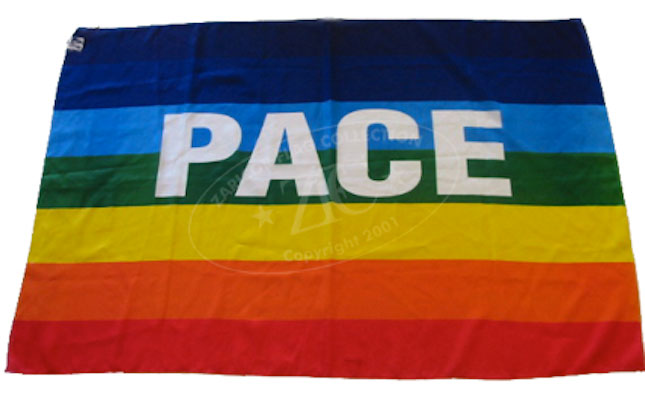
|
|
ZFC1003 Italian Pace da tutti i balconi, “Peace from every balcony movement.†The rainbow flag was first utilized in Italy during a Peace march in 1961. In 2002, in protest of the impending Iraq War, it quickly became associated with the Pace da tutti i balconi (“peace from every balconyâ€) movement where the Italian word PACE, “PEACE†was displayed prominently across the top of the flag. The flag has since spread worldwide. It should not be confused with the Gay Pride Rainbow flag made popular in the United States in the 1980s. Read more
|















